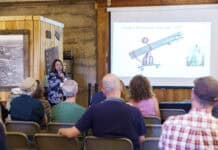Before Sedonans find themselves swimming in a sea of wastewater, City Council finally decided how to dispose of it.
On July 8, council approved a report that recommends the city dispose of its future wastewater by aquifer recharge. Council also agreed to set up a task force to study the issue.
The city has contracted with the Tempe-based engineering firm Burgess & Niple to identify alternatives for off-site disposal of treated wastewater from the city’s Wastewater Reclamation Plant.
By Alison Ecklund
Before Sedonans find themselves swimming in a sea of wastewater, City Council finally decided how to dispose of it.
On July 8, council approved a report that recommends the city dispose of its future wastewater by aquifer recharge. Council also agreed to set up a task force to study the issue.
The city has contracted with the Tempe-based engineering firm Burgess & Niple to identify alternatives for off-site disposal of treated wastewater from the city’s Wastewater Reclamation Plant.
Currently, the city disposes of its roughly 1.2 million gallons of wastewater a day by spray irrigation, wetlands and evaporation from holding ponds on 426 acres southwest of the city.
About 282 of those acres are used for spray irrigation.
City staff reported the plant can currently dispose of up to 1.6 million gallons a day. Considering each house contributes about 200 gallons a day, the wastewater plant will reach capacity when about 15,000 housing units are built or when existing neighborhoods are connected to the sewer system, Public Works Director Charles Mosley said.
“How fast will sewer areas build out? Ten years? 30 years?” Mosley asked. “But if we’re adding areas like we have been, then you will reach 1.6 million [gallons a day] faster.”
Since the recharge solution would take three to five years to put in place, Burgess & Niple Business Development Director James Campbell suggested starting it now, before the plant reaches capacity.
The report recommends the city pursue aquifer recharge at Gyberg wash on state lands about 4.5 miles southwest of the plant.
Although the estimated cost of developing a recharge facility is about $3.5 million, the city can recover the cost through the sale of water credits, Campbell told the board.
Water credits are developed through the storage of water in the aquifer. Whoever buys the credits has the right to withdraw the water, Mosley said.
“The rule is, when you put water into the ground, someone can withdraw it in a certain area,” Mosley said. In this case, anyone in the Verde Valley sub-basin could buy the credits.
According to the staff report, prices for water have varied from $3,000 to $19,500 to $45,000 per acre-foot. The credits can be sold or leased, and water credits usually assure a 100-year water supply.
Sedona Mayor Rob Adams was skeptical that there is a demand to buy Sedona’s water credits.
“After speaking to a number of people, there are no reasons for anyone to buy water from us because people can build wells in this area,” Adams said. “Why would we go down that path when there is no immediate demand for that water?”
Campbell agreed that there is no shortage of water in Sedona, but there is a shortage in Prescott and Flagstaff, he said.
“There are five or more developers who are not doing anything because they don’t have their water supply,” Campbell said. “There are definitely markets
for it.”
Regardless of whether the city sells the credits or not, recharge is the only viable solution at this point, Councilwoman Nancy Scagnelli said.
“Even if we did wetlands on the north side of the road [Highway 89A] and sprayed a golf course or something, would we still need to find a place to discharge?” she asked Campbell, who agreed.
“We need to do this, regardless,” Scagnelli said, of recharging the city’s wastewater.
Before moving on to form a task force on the issue, council approved 6-1 a motion to direct staff to begin the process of seeking permits for aquifer recharge and a request for proposal. Adams was the lone “no” vote.
“I don’t think we’ve completely decided that this situation is the way to go. I don’t think we’ve really analyzed how we used the land,” Adams said. “I think the citizens committee will do their work and come back with a lot more questions answered.”
Council approved 7-0 to form a nine-member task force to study effluent use and land use.
The committee will be made up of seven community members, one nominated by each of the council members.
The eighth member will come from the Water Conservation Advisory Committee; Anita McFarland, chair of that committee, will chair the task force.
Council asked that the task force, which should be put together by September, come back with a status report in February, before it starts planning next year’s budget.
It also approved an initial budget of $30,000 for the committee.
“I think the committee should be able to look at all aspects and bring back to you that we’ve evaluated all of them and these are the ones we feel are the best,” McFarland told council. “That’s our responsibility — to look at all of these possibilities that have come up over time.”
Alison Ecklund can be reached at 282-7795, Ext. 125, or e-mail
aecklund@larsonnewspapers.com
